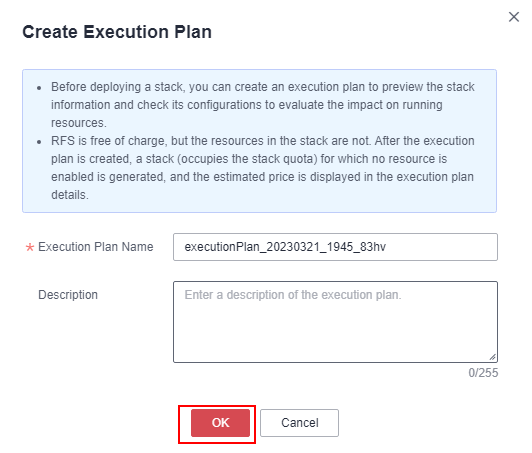Quick Deployment
This section describes how to deploy the Source Code Compilation with Jenkins solution.
|
Parameter |
Type |
Mandatory |
Description |
Default Value |
|---|---|---|---|---|
|
vpc_name |
String |
Yes |
The prefix of a Virtual Private Cloud (VPC) name. The VPC naming format is {vpc_name}_vpc. This template uses a newly created VPC and the VPC name must be unique. The prefix can contain 1 to 57 characters and can include letters, digits, underscores (_), hyphens (-), and periods (.). |
build_system_based_on_jenkins_demo |
|
secgroup_name |
String |
Yes |
The prefix of a security group name. The security group naming format is {secgroup_name}_secgroup. This template uses a newly created security group. For details about how to configure security group rules, see the (Optional) Modifying Security Group Rules. The prefix can contain 1 to 55 characters and can include letters, digits, underscores (_), hyphens (-), and periods (.). |
build_system_based_on_jenkins_demo |
|
ecs_name |
String |
Yes |
The prefix of the Jenkins and Gerrit server names. The naming format is {ecs_name}-jenkins or {ecs_name}-gerrit. The server name must be unique. The prefix can contain 1 to 56 characters and can include letters, digits, underscores (_), hyphens (-), and periods (.) |
build_system_based_on_jenkins_demo |
|
jenkins_flavor |
String |
Yes |
The flavor of the Jenkins server. The default flavor is c6.xlarge.2 (4U8G). For more flavors, see the deployment guide. |
c6.xlarge.2 |
|
gerrit_flavor |
String |
Yes |
The flavor of the Gerrit server. The default flavor is c6.xlarge.2 (4U8G). For more flavors, see the deployment guide. |
c6.xlarge.2 |
|
ecs_password |
String |
Yes |
The initial password of the Jenkins and Gerrit servers. After an ECS is created, log in to the ECS console and change the password by referring to the instructions provided in deployment guide. It can include 8 to 26 characters and must include at least three of the following character types: uppercase letters, lowercase letters, digits, and special characters (!@$%^-_=+[{}]:,./?). The password cannot contain any username or the username spelled backwards. The administrator is root. |
Left blank |
|
jenkins_disk_size |
Number |
Yes |
The size of the data disk attached to the Jenkins server. The unit is GB. Value range: 10 to 32768. The default value is 500. |
500 |
|
gerrit_disk_size |
Number |
Yes |
The size of the data disk attached to the Gerrit server. The unit is GB. Value range: 10 to 32768. The default value is 500. |
500 |
|
jenkins_eip_size |
Number |
Yes |
The bandwidth size of the Elastic IP (EIP) bound to the Jenkins server. The EIP is billed by bandwidth. The unit is Mbit/s. Value range: 1 to 2000. The default size is 10 Mbit/s. |
10 |
|
gerrit_eip_size |
Number |
Yes |
The bandwidth size of the Elastic IP (EIP) bound to the Gerrit server. The EIP is billed by bandwidth. The unit is Mbit/s. Value range: 1 to 2000. The default size is 10 Mbit/s. |
10 |
|
bucket_name |
String |
Yes |
The name of the OBS bucket for storing compiled code. The name must be globally unique in OBS. It must include 3 to 63 characters and can include only lowercase letters, digits, hyphens (-), and periods (.). It cannot be an IP address. |
build-system-based-on-jenkins-demo |
- Log in to Huawei Cloud Solution Best Practices and choose Source Code Compilation with Jenkins. Click Deploy to switch to the Create Stack page.
Figure 1 Selecting a solution

- On the Select Template page, click Next.
Figure 2 Select Template

- On the Configure Parameters page, enter a stack name, configure parameters based on Table 1, and click Next.
Figure 3 Configure Parameters

- On the Configure Stack page, select the rf_admin_trust agency and click Next.
Figure 4 Configure Stack

- On the Confirm Configurations page, confirm the configurations and click Create Execution Plan.
Figure 5 Confirm Configurations

- In the displayed Create Execution Plan dialog box, enter an execution plan name and click OK.
Figure 6 Create Execution Plan

- Wait until the status of the execution plan changes to Available, and then click Deploy in the Operation column. In the displayed dialog box, click Execute.
Figure 7 Execution plan created
 Figure 8 Confirming the execution plan
Figure 8 Confirming the execution plan
- Wait until the deployment is successful and click the Events tab to view details.
Figure 9 Resources created
 Figure 10 Deployment completed
Figure 10 Deployment completed
Feedback
Was this page helpful?
Provide feedbackThank you very much for your feedback. We will continue working to improve the documentation.See the reply and handling status in My Cloud VOC.
For any further questions, feel free to contact us through the chatbot.
Chatbot





